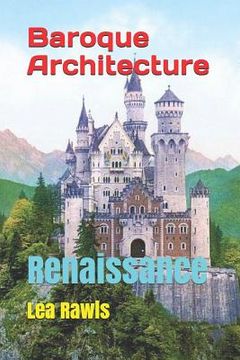Reseña del libro "Baroque Architecture: Renaissance (en Inglés)"
Baroque architecture is the building style of the Baroque era, begun in late 16th-century Italy, that took the Roman vocabulary of Renaissance architecture and used it in a new rhetorical and theatrical fashion, often to express the triumph of the Catholic Church. It was characterized by new explorations of form, light and shadow, and dramatic intensity. Common features of Baroque architecture included gigantism of proportions; a large open central space where everyone could see the altar; twisting columns, theatrical effects, including light coming from a cupola above; dramatic interior effects created with bronze and gilding; clusters of sculpted angels and other figures high overhead; and an extensive use of trompe-l'oeil, also called "quadratura," with painted architectural details and figures on the walls and ceiling, to increase the dramatic and theatrical effect. Whereas the Renaissance drew on the wealth and power of the Italian courts and was a blend of secular and religious forces, the Baroque was, initially at least, directly linked to the Counter-Reformation, a movement within the Catholic Church to reform itself in response to the Protestant Reformation. Baroque architecture and its embellishments were on the one hand more accessible to the emotions and on the other hand, a visible statement of the wealth and power of the Catholic Church. The new style manifested itself in particular in the context of the new religious orders, like the Theatines and the Jesuits who aimed to improve popular piety.Lutheran Baroque art, such as the example of Dresden Frauenkirche (1726-1743), developed as a confessional marker of identity, in response to the Great Iconoclasm of Calvinists. The architecture of the High Roman Baroque can be assigned to the papal reigns of Urban VIII, Innocent X and Alexander VII, spanning from 1623 to 1667. The three principal architects of this period were the sculptor Gianlorenzo Bernini, Francesco Borromini and the painter Pietro da Cortona and each evolved his own distinctively individual architectural expression.Dissemination of Baroque architecture to the south of Italy resulted in regional variations such as Sicilian Baroque architecture or that of Naples and Lecce. To the north, the Theatine architect Camillo-Guarino Guarini, Bernardo Vittone and Sicilian born Filippo Juvarra contributed Baroque buildings to the city of Turin and the Piedmont region.A synthesis of Bernini, Borromini, and Cortona's architecture can be seen in the late Baroque architecture of northern Europe, which paved the way for the more decorative Rococo style.By the middle of the 17th century, the Baroque style had found its secular expression in the form of grand palaces, first in France-with the Château de Maisons (1642) near Paris by François Mansart-and then throughout Europe.During the 17th century, Baroque architecture spread through Europe and Latin America, where it was particularly promoted by the Jesuits.

